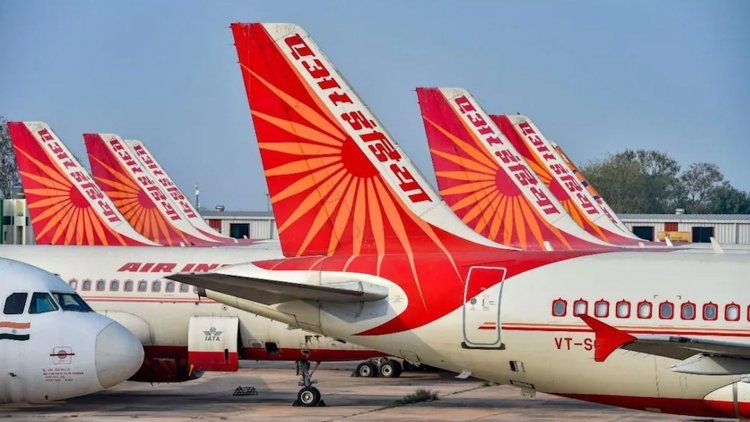Why is it a good idea for Air India to acquire a gigantic aircraft order?
The anticipated aircraft order will improve the airline's operational efficiency, contribute to brand development, and lessen delays brought on by aircraft maintenance problems. The older aircraft in its fleet limit efficiency, and replacing them will be helpful in fending off competition from low-cost carriers and airlines located in the Gulf.

A massive order for both wide-body and narrow-body aircraft is about to be placed by Air India, which is now a part of the Tata Group. According to media rumours, Boeing or Airbus will receive the 200–300 aircraft order, or it may even be split between the two aircraft manufacturers.
The Boeing 777, 747, and 787 are among the 26 owned and 23 leased wide-body aircraft that Air India currently operates. The Airbus A319, A320, and A321 are among the 44 owned and 35 leased narrow-body aircraft listed on the Air India website.
When compared to IndiGo's more than 280 aircraft, the fleet may appear to be huge. IndiGo has 400 additional aircraft on order, which helps put the fleet size in context.
What's intriguing is why a huge aircraft order is now required at a time when the airline is focused on other developments.
Notably, the airline is awaiting the arrival of Campbell Wilson, its new CEO and managing director, and it is also managing a Voluntary Retirement Scheme (VRS) for its employees.
A massive effort has also been started by Tata Group to unite Air India Express and AirAsia India, and eventually to merge the new company with Air India.
However, according to industry observers, the state of the market today justifies expanding Air India's fleet.
Meeting both current and future needs
The anticipated aircraft order will improve the airline's operational efficiency, contribute to brand development, and lessen delays brought on by aircraft maintenance problems.
The efficiency of the older generation of aircraft is constrained, and their replacements will be useful in fending off competition from low-cost carriers and Gulf-based airlines.
The new aircraft will help the airline meet both current and future passenger demand, according to Mark Martin, CEO of aviation consulting firm Martin Consulting.
The situation is especially plausible in view of the devastating effects the COVID-19 outbreak has had on the aviation sector. Growth has been hampered by high fuel prices, particularly since Russia's invasion of Ukraine in February.
However, considering the size of the nation and the rising demand for international travel, Indian aviation has a promising future.
Recent data points indicate an increase in the number of passengers carried by domestic aircraft each day.
Fresh growth cycle is beginning
After the third wave of the pandemic, domestic passenger traffic recovered strongly, reaching 98 percent of pre-Covid levels in April and May 2022, according to credit rating agency ICRA.
Although it has fluctuated, the daily passenger count currently exceeds 300,000 and has recently approached 400,000.
The timing is ideal and crucial since, following COVID-19, the travel and tourism sector is anticipated to go through a development cycle lasting several years, according to Martin.
The main concern is that of capacity that will be added once Air India expands its fleet; recovery is currently well-balanced and in accordance with projections.
Air India has the largest market share on the international front.
Market share abroad
When it came to transporting Indians overseas in FY21, Air India held a market share of over 17%. But the territory is not uncontested. IndiGo is challenging Air India's hegemony with a sizable fleet and orders for brand-new ultra long-haul aircraft.
Due to the operational constraints of its workhorse A320 family of aircraft, IndiGo, which now has the greatest domestic market share, is constrained in its range. As of right now, it travels outside of Asia, with routes to Turkey in the west and Vietnam in the east.
After the airline acquires the extra-long-range A321XLR, a member of the Airbus A320 family, the situation could alter.
In order to raise frequencies, fully use its precious international airport slots, and maintain its Star Alliance membership, Air India would also need new aircraft.
Additionally, commencing flights to new locations calls for more planes.
During the COVID-19 evacuation programme, Air India recently showed that it could run flights to 60 foreign cities. The airline, among others, offers lucrative routes to London, New York, San Francisco, and Frankfurt. It will be able to open lines to Africa, East Asia, and potentially South America thanks to the new long-haul aircraft.
Analysts cited the success of Turkish Airlines, which flies to about 200 locations, as an example. In the case of Air India, the airline will be able to transport not just the enormous Indian population base but also more foreign tourists.
In order to broaden its scope and fully benefit from these advantages, the airline thus requires new aircraft. Additionally, the airline will be able to provide new goods at various price points and enhance customer service thanks to new aircraft.
Recent complaints from passengers over outdated planes go counter to the group's overall goals to elevate the airline to a global icon of Indian hospitality. The airline will likely benefit from significant savings associated with large orders by placing a mega order.
Rejuvenation of a brand
According to Suman Chowdhury, Chief Analytical Officer, Acuité Ratings & Research, "Air India currently has a somewhat older fleet as compared to some of its contemporaries, and the induction of new aircraft in the fleet will help to rejuvenate the brand."
"Given the precarious situation in the global aviation sector, this may be the appropriate time for Air India to negotiate a bulk contract with OEMs for either outright purchase or lease, which will boost its competitiveness over the long term."
Narrow-body planes typically cost roughly $80 million on a list price basis, while wide-body planes cost upwards of $300 million.
As it would give additional comfort to the stakeholders, including the lenders, lessors, and aircraft OEMs, finance support from the Tata Group will be a key differentiator for Air India and its affiliates, according to Chowdhury.
Any offset commitments may potentially be used by the Tata Group. Under such requirements, its massive industrial base already produces parts for military aircraft.
Additionally, it is anticipated that new aircraft will use less fuel, reducing the cost of aviation turbine fuel, which has surged as a result of the ongoing geopolitical situation in Europe.
According to Jagannarayan Padmanabhan, Director & Practice Leader, Transport & Logistics at Crisil Infrastructure Advisory, "Having an efficient fleet is vitally crucial as fuel cost is approximately 40% of the Opex." "A new-generation fleet will undoubtedly aid in protecting Air India's margins."




 admin
admin 



















